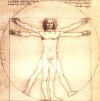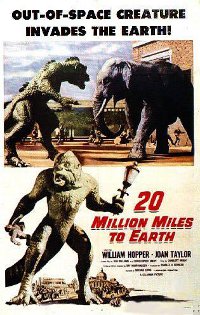 Any movie calling itself 20 Million Miles To Earth is bound to attract attention to its use of numbers. While Venus can be about 20 million miles away, I am pretty sure that any flight from Venus to the Earth is going to take quite a bit more than 20 million miles of flight. Okay, maybe I’m being nick-picky, but ever since my confusion over Solo’s Kessel Run comment 33 years back (since explained), numbers in movies have always concerned me.
Any movie calling itself 20 Million Miles To Earth is bound to attract attention to its use of numbers. While Venus can be about 20 million miles away, I am pretty sure that any flight from Venus to the Earth is going to take quite a bit more than 20 million miles of flight. Okay, maybe I’m being nick-picky, but ever since my confusion over Solo’s Kessel Run comment 33 years back (since explained), numbers in movies have always concerned me.
But I didn’t get much time to dwell on it, as the Earth-side action starts off quick! When a giant rocketship crashes into the sea near a group of “Sicilian” fishermen, we know that something exciting is about to happen. The fishermen decide to row on home after this turns of events, except for one boat who with the fateful words, “What are we? Children or men of the sea?” row out to the ship. The enormous space ship is close enough to be pretty tempting, after all, even with how terribly fake its crash-landing was. Plus, conveniently, there is a big hole in the ship right at water level.
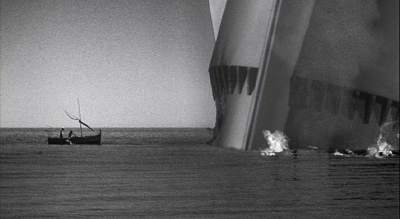
So in our brave men of the sea go. Inside they find two survivors of the crash who are surprisingly not that alien after all. Well, maybe not surprising as, for such a futuristic ship on the exterior, the interior has the definite feel of a ship from the early 20th century.
The key to this story, though, is what they don’t rescue. A canister from the ship winds up on the shore where the little boy Pepe finds it and hides it away. Pepe is making a rather strange decision here, seemingly brought on by his desire for a cowboy hat from the great country of Texas, but maybe he is just odd as he makes another strange number reference by saying “a small kilometer”, but I digress. Of course little Pepe opens this canister, also implying that he hasn’t seen Return of the Living Dead (making him an odd one many times over) and sells off the gelled glob he find inside to a local traveling zoologist.
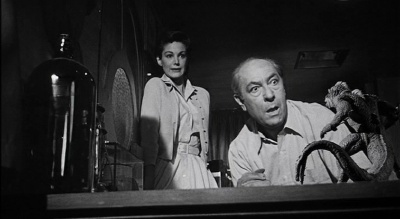
What we end up with is a real life creature from Venus! One that is is growing at a phenomenal rate due to Earth’s atmosphere, and, of course, he gets away and then begins the chase!
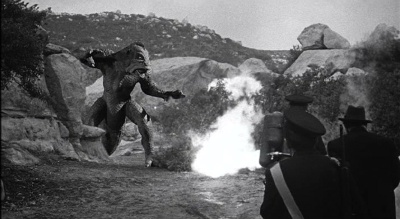
While this is a Harryhausen classic, the accent here is on Harryhausen, rather than classic. The monster is all right, and the scene where he gives humanity a turn with his art is funny, there just isn’t as much exciting eye candy as in his later features. The high point is that the star of the movie was William Hopper, who I associate so strongly with his Paul Drake role that anytime I see him in anything else it seems noteworthy.
While in a movie like this the lack of scene continuity is a given, I still think that they should have paid a little more attention to the details. For instance, when in discovering that the ship has crash landed, a General points to the Mediterranean and says “20,000 leagues under the sea”. What are we supposed to be thinking he is trying to say? Does he think that the ship landed in the sea, careened through the earth and popped out the other side? Does he have no grasp of what a league is (unlikely for a general, I would hope)? Is he trying to make of show of levity in the face of gravity by implying that they are going to be sailing around the earth under the sea? Does he just like the phrase? Should I just relax?
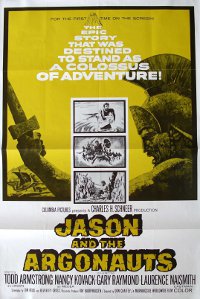 One of the two great fantasy classics of my youthful TV viewing days (along with The Seventh Voyage of Sinbad) Jason and the Argonauts is one of Harryhausen’s great masterpieces. Featuring some of Harryhausen’s classic stop-motion monsters, along with a mob of gods and some great adventuring on the high seas. Jason and the Argonauts is the story of a group of heroes (including Jason and the troublesome and bear skin clad Heracles) who set off in search of the Golden Fleece. This all happens against the background of Zeus’ game playing. As, when many years before, Zeus gives favor to a king by allowing him to conquer a rival, he also tells him that one of those rivals’ three children will one day unseat him. Jason happens to be the son of that defeated king, and one of his crew members happens to be that the deposer’s son, hoping to prevent Jason from completing his quest. Personally, I would assume that if Zeus told me that was the deal, then I would assume that he would be right. But this fellow (stupid mortal) decides that he can defeat Zeus’ set-up.
One of the two great fantasy classics of my youthful TV viewing days (along with The Seventh Voyage of Sinbad) Jason and the Argonauts is one of Harryhausen’s great masterpieces. Featuring some of Harryhausen’s classic stop-motion monsters, along with a mob of gods and some great adventuring on the high seas. Jason and the Argonauts is the story of a group of heroes (including Jason and the troublesome and bear skin clad Heracles) who set off in search of the Golden Fleece. This all happens against the background of Zeus’ game playing. As, when many years before, Zeus gives favor to a king by allowing him to conquer a rival, he also tells him that one of those rivals’ three children will one day unseat him. Jason happens to be the son of that defeated king, and one of his crew members happens to be that the deposer’s son, hoping to prevent Jason from completing his quest. Personally, I would assume that if Zeus told me that was the deal, then I would assume that he would be right. But this fellow (stupid mortal) decides that he can defeat Zeus’ set-up.
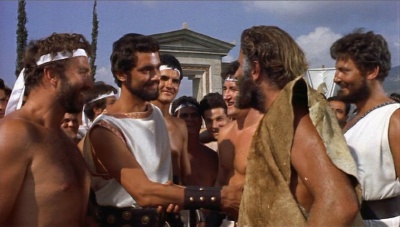
While it may seem like another grand human adventure, it is, like all other endeavors, just a game for the gods, to help them pass the time. In this case, a chess game between that good cop/bad cop team of Hera (the always delightful Honor Blackman, only a year away from becoming infamous as Pussy Galore) and Zeus.
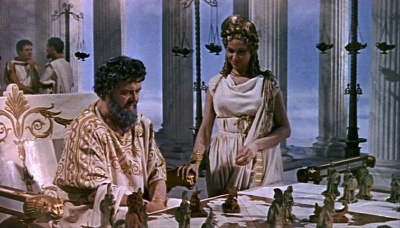
Their voyage to find the golden fleece is fraught with dangers, but also with some convenient assistance from Hera who accompanies them in the forms of the masthead of the ship. She sends them to an island for supplies with the warning not to take anything but food and when Heracles and his pal Hylas stumble upon the treasure chamber below the great bronze form of the islands protector, Talos, Heracles just can’t help but steal a giant golden brooch pin to use as a javelin. Of course Talos, following the creed of neither a borrower nor a lender be, cranes his creaky neck their way and sets off in a vengeful pursuit.
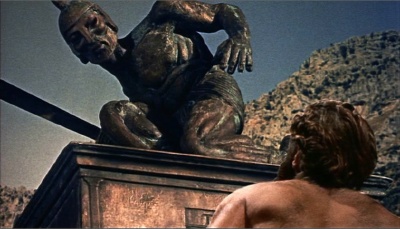
I watched this part of the movie with my daughter who insisted on watching the scenes of Talos moving around over and over again… With frequent pausing when she got scared. I think we watched them about 5 times. But I don’t blame her as this is the first great Harryhausen monster sequence in the film, and one of the best and longest. Plus, Talos is just a bad dude and, hey, those snivelly little people did steal his brooch pin!
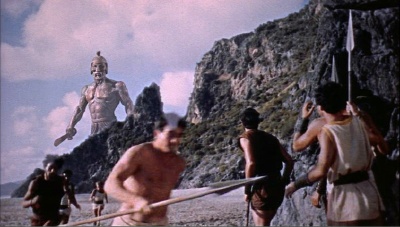
This movie is great. The effects are great. Even with it being nearly 50 years old, the great stop-motion effects don’t slow down the appreciation or the “buy-in” of the movie. The splashing effects, on the other hand, kind of killed my buy-in because when the Argo is dropped into the sea by Talos and when they are traveling through the treacherous straight, the water drops from the splashes make it all too obvious that the things falling in the water were really quite small. But they gain an enormous amount of credit in my book for traveling through most of the movie in an actual ship in actual water. That is pretty cool. And, of course, the monsters… Talos, The Hydra and the teeth of the hydra (Harryhausen’s famous skeletons).









